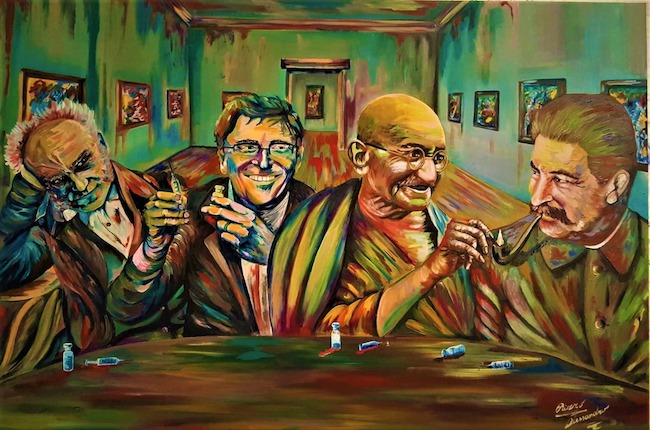Le tecniche pittoriche, o meglio, gli stili, nella contemporaneità spesso non riescono a mantenere i tratti distintivi e identificativi che avevano nel passato perché gli artisti attuali prendono spunto, mescolano e sperimentano per dar vita a una cifra pittorica assolutamente personale e individuale; questo tipo di atteggiamento è in grado da un lato di superare i limiti imposti dalle correnti pittoriche del Novecento, dall’altro di gettare le basi per le ricerche degli artisti di domani. Il protagonista di oggi sceglie inconsapevolmente di dar vita a un linguaggio pittorico singolare in cui unisce magistralmente due tra i più rivoluzionari movimenti che hanno contraddistinto il secolo scorso.
Tutto ciò che nel Novecento poteva essere contro l’arte tradizionalmente intesa, era accolto come innovazione significativa per compiere quel percorso di distacco, di controtendenza rispetto alle regole accademiche ormai in contrasto con la modernità e gli stravolgimenti che la società stava affrontando; in questo quadro l’Espressionismo costituì una rottura netta con il Realismo ma anche con l’Impressionismo e tutta l’arte precedente per il suo desiderio quasi prepotente di distaccarsi dall’estetica e dall’equilibrio armonico per seguire invece quei moti interiori disordinati, a volte aggressivi, intensi, irrefrenabili che appartenevano a un’interiorità troppo a lungo scissa dall’espressione pittorica. Pertanto era necessario rinunciare all’armonia, alla prospettiva, alla stesura del colore così come intesi dal punto di vista classico e accademico e trovare un modo secondo il quale l’immagine dovesse adeguarsi all’impetuosità del sentire, anche se per questo dovesse lasciar emergere il brutto, il deforme, l’irreale coloristico; le opere di Vincent Van Gogh come quelle di Egon Schiele, sovvertivano l’equilibrio estetico e la realtà per entrare nel mondo delle profondità, delle insicurezze, delle ossessioni e della follia, quasi come se il loro fosse un grido di dolore nei confronti di un mondo fatto di regole, di falsità, di incertezze dovute alle minacce delle guerre e al cambiamento di una società in cui non si riconoscevano più. Con il trascorrere dei decenni quella netta opposizione andò affievolendosi e concentrandosi invece su tematiche più contemporanee, sullo studio dell’evolversi del modo di vivere che ebbe un’ampia accelerazione dopo la fine della seconda guerra mondiale, quando cioè le devastazioni erano alle spalle e il processo di ricostruzione aveva determinato un crescente benessere; fu esattamente in questo contesto che negli Stati Uniti prima e in Europa dopo, nacque uno stile artistico anch’esso rivoluzionario, seppur con modalità diverse rispetto all’Espressionismo, e che intendeva mettere in risalto la tendenza consumistica, popolare e più superficiale di quegli anni. Dunque l’arte doveva parlare un linguaggio chiaro e semplice anche per andare a coinvolgere un pubblico più ampio che diversamente mai si sarebbe avvicinato a un’opera, ma anche per permettere alla nuova classe borghese di poter avere in casa qualcosa di prezioso che non avesse dei costi eccessivamente inarrivabili. Questa fu la spinta che indusse il grande innovatore Andy Warhol a dar vita alla Pop Art, uno stile che rendeva protagonisti oggetti quotidiani, quelli che entravano nelle case dei consumatori, facendoli diventare icone rappresentative dell’epoca tanto quanto lo erano gli affascinanti personaggi del cinema, del mondo dello spettacolo e della politica. Le opere non erano più copie uniche vendibili solo a collezionisti con grandi capacità economiche bensì venivano prodotte in serie limitate attraverso l’uso della tecnica serigrafica che rese dunque l’arte più democratica e accessibile; ciò che contraddistinse il movimento di Warhol fu lo sguardo ammirato ma in fondo anche critico della società del tempo, consumistica, ecco il motivo degli oggetti protagonisti assoluti di intere opere, e all’inseguimento di nuovi miti come gli attori di Hollywood. L’arte di Alessandro Rizzo si ispira a grandi artisti di un passato più remoto, come John Atkinson Grimshaw maestro dei paesaggi notturni dell’epoca vittoriana e Ivan Konstantinovič Ajvazovskij paesaggista romantico russo, per studiare e sperimentare la sua inclinazione naturale, quella verso l’espressione pittorica, dando tuttavia vita a uno stile assolutamente personale che non può che collocarsi a metà tra Espressionismo, per le tonalità cromatiche irreali ma affini alla narrazione dei personaggi o delle vedute riprodotte così come allo sguardo emozionale dell’artista, e il Neopop, per la caratteristica di mettere in luce, spesso in chiave ironica, personaggi dell’attualità insieme ad altri del passato, oppure miti moderni che per la loro popolarità hanno lasciato un segno nella storia.
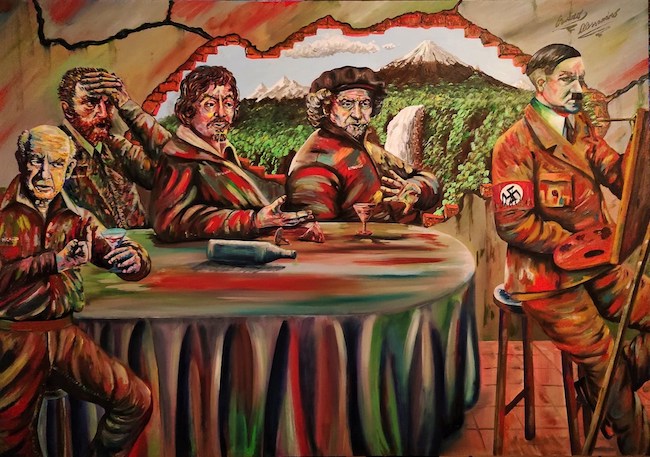
Il suo approccio pittorico si avvale di una notevole abilità figurativa che usa per lasciare un messaggio all’osservatore, una riflessione e interpretazione del tutto personale sugli accadimenti del presente, sulla curiosità di capire quanto sarebbe stato compreso dalle grandi figure del passato questo strano modo di affrontare ciò che si sta verificando nella realtà contemporanea; le tonalità utilizzate sono a metà tra il reale e l’irreale perché è essenziale che si accordino e sottolineino il messaggio che Alessandro Rizzo desidera trasmettere all’osservatore, coinvolgendolo di fatto non solo nel suo punto di vista bensì anche chiamandolo a una profonda riflessione su ciò che sceglie di mettere in luce, quasi come se attraverso il punto focale dell’artista si trovasse davanti a qualcosa di non evidenziato in precedenza.
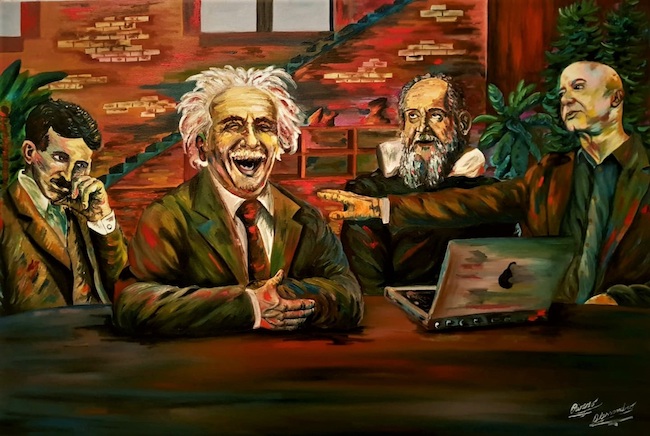
Il dialogo tra passato e presente è protagonista assoluto della tela La derisione in cui un divertito Albert Einstein sembra prendere in giro la sicurezza di Jeff Bezos, fondatore di Amazon, che gli sta mostrando le potenzialità della sua scoperta; il grande fisico tedesco non può che ridere davanti a qualcosa di tanto effimero come il servizio dato da Bezos e illustrato come una grande scoperta mentre la vittima della sua derisione sembra chiedere sostegno a Nikola Tesla che resta nel suo angolo, scoraggiato dalla mancanza di sostanza di ciò che è davanti ai suoi occhi mentre Galileo Galilei assiste incredulo. La narrazione di Rizzo è dissacratoria, prende in giro i nuovi miti mettendoli accanto a chi ha davvero scritto pagine importanti e fondamentali della scienza e della tecnica non immaginando che le loro scoperte sarebbero state utilizzate per scopi tanto utilitaristici ed effimeri.
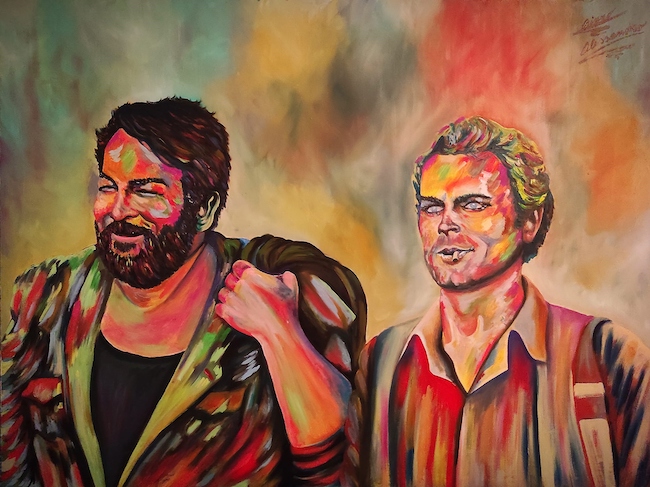
Quando invece ritrae personaggi del mondo del cinema l’artista svela tutta la sua ammirazione nei confronti di figure positive, capaci di conquistare il pubblico con la loro spontaneità, con la loro purezza e il mantenimento di valori fondamentali che nella contemporaneità sembrano andati perduti ma che ancora esistono all’interno di chi in un passato recente è cresciuto ed è stato educato; la tela Bud & Terence celebra i due mostri sacri del cinema italiano, quello leggero, quello in cui osservare le avventure dei due uomini che si muovevano mettendo al loro posto i cattivi anche a suon di botte suscitava ilarità, perché, diversamente da oggi, c’era la certezza che il bene vincesse sempre. In qualche modo emerge una sottile nostalgia da parte di Rizzo per quegli anni in cui tutto era più semplice, più stabilito, il confine tra il giusto e lo sbagliato era tracciato e le persone si muovevano su quella linea; le macchie di colore che contraddistinguono i due personaggi rappresentano quelle emozioni suscitate negli spettatori, passione, forza, determinazione e senso della giustizia, mentre lo sfondo è completamente sfumato per sottolineare la loro appartenenza a un periodo che oggi non esiste più.
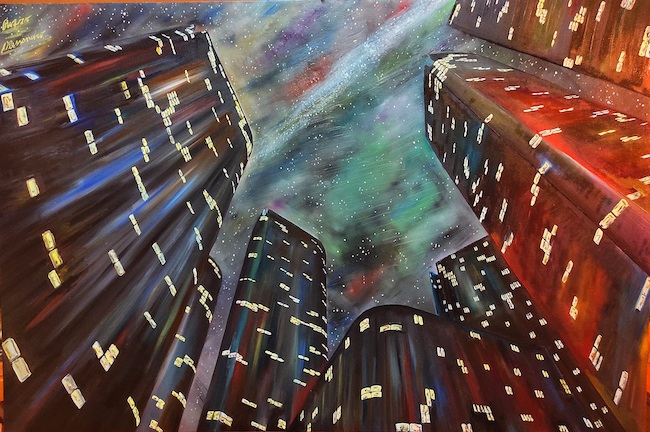
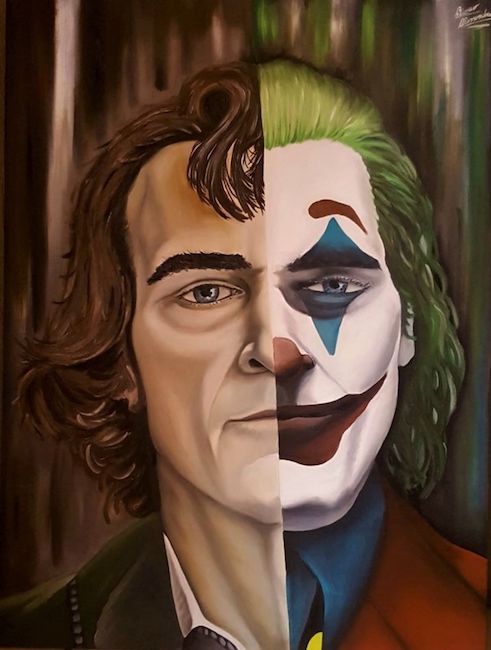
E ancora nell’opera Notte in città sembra riprodurre un’indefinita metropoli statunitense contraddistinta dai grattacieli illuminati, un luogo che potrebbe essere protagonista di un fumetto o forse è quella stessa Gotham City in cui collocare il suo Jocker; i riferimenti e i legami con le icone del mondo moderno sono la caratteristica principale di Alessandro Rizzo che con abilità riproduttiva, il volto di Joaquin Phoenix, grande interprete dell’antagonista storico di Batman, è reale ma con una forte impronta Pop, lascia nelle sue opere un messaggio che va oltre l’immagine stessa, sottintende la sua idea, la sua considerazione su un mondo attuale che non sembra andare nella direzione sperata inducendo l’individuo ad adeguarsi o a contestare gli accadimenti e ciò che sembra inevitabile.
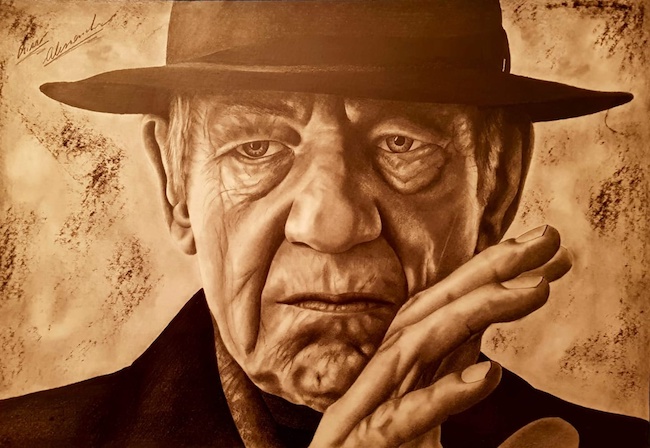
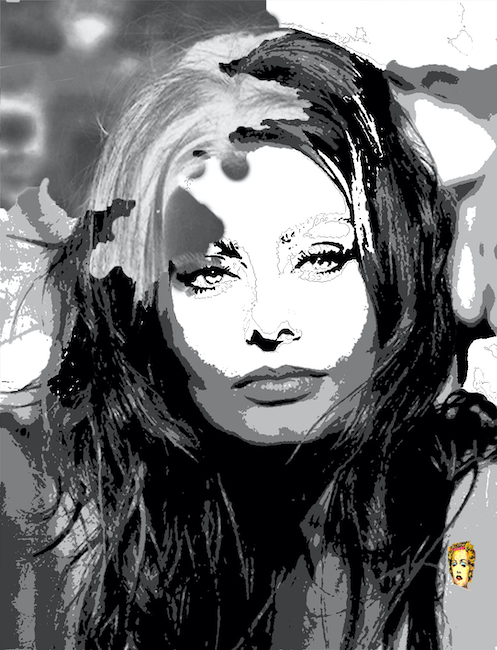
Alessandro Rizzo, artista lombardo, non si limita ai dipinti in olio su tela bensì ama anche cimentarsi con il carboncino e la grafite e con la Digital Art, mostrando e confermando non solo la sua predilezione per il ritratto ma anche la sua abilità narrativa ed espressiva.
ALESSANDRO RIZZO-CONTATTI
Email: alessandro.rizzo76@yahoo.it
Sito web: https://www.rizzoalessandro.com
Facebook: https://www.facebook.com/alessandro.rizzo.3154
Instagram: https://www.instagram.com/dalcarboncinoallapittura/
Pinterest: https://www.pinterest.it/alessandrorizzo76/_created/
Tik Tok: https://www.tiktok.com/@alessandrorizzoart?lang=it-IT
Between Neopop and Expressionism, a journey through the portraits by Alessandro Rizzo
Painting techniques, or rather, styles, in the contemporary world often fail to maintain the distinctive and identifying traits they had in the past because today’s artists take their cue, mix and experiment to give life to an absolutely personal and individual pictorial style; this type of attitude is capable, on the one hand, of overcoming the limits imposed by the pictorial currents of the 20th century and, on the other, of laying the foundations for the research of tomorrow’s artists. Today’s protagonist unwittingly chooses to create a singular pictorial language in which he masterfully combines two of the most revolutionary movements of the last century.
Everything in the 20th century that might have been against traditionally intended art was accepted as a significant innovation to achieve that path of detachment, of countertendency to the academic rules that were now in contrast with modernity and the upheavals that society was facing; within this framework, Expressionism constituted a clear break with Realism, but also with Impressionism and all previous art for its almost overbearing desire to detach itself from aesthetics and harmonic balance to instead follow those disordered, sometimes aggressive, intense, unstoppable inner motions that belonged to an interiority too long separated from pictorial expression. It was therefore necessary to renounce harmony, perspective, and colour draftsmanship as intended from the classical and academic point of view and to find a way according to which the image had to adapt to the impetuosity of feeling, even if it had to allow the ugly, the deformed, the unrealistic colour to emerge; Vincent Van Gogh’s artworks, like those of Egon Schiele, subverted the aesthetic balance and reality in order to enter the world of depths, insecurities, obsessions and madness, almost as if theirs were a cry of pain against a world made of rules, falsehoods, uncertainties due to the threats of wars and the change of a society in which they no longer recognised themselves.
With the passing of the decades, that stark opposition faded away and focused instead on more contemporary themes, on the study of the evolution of the way of life that had a great acceleration after the end of the Second World War, when the devastation was behind and the process of reconstruction had led to a growing well-being; it was exactly in this context that first in the United States and then in Europe, was born a revolutionary artistic style, albeit in a different way from Expressionism, and which intended to highlight the consumerist, popular and more superficial tendencies of those years. Therefore, art had to speak a clear and simple language also in order to involve a wider public that would otherwise never have approached a work of art, but also to allow the new middle class to have something precious in the home that did not have an excessively unaffordable cost. This was the impetus that led the great innovator Andy Warhol to give birth to Pop Art, a style that made everyday objects, those that entered the homes of consumers, the protagonists, becoming repesentative icons of the era as were the fascinating personalities of the cinema, show business and politics. The artworks were no longer unique copies that could only be bought by collectors with great economic capacity, but were produced in limited series through the use of the silk-screen printing technique, which therefore made art more democratic and accessible. What distinguished Warhol’s movement was the admiring but ultimately critical look at the consumerist society of the time, hence the reason for the objects that were the absolute protagonists of entire works, and in pursuit of new myths such as Hollywood actors.
Alessandro Rizzo’s art is inspired by great artists of the more distant past, such as John Atkinson Grimshaw master of nocturnal landscapes of the Victorian era and Ivan Konstantinovič Ajvazovskij Russian Romantic landscape painter, to study and experiment with his natural inclination, that towards pictorial expression, nevertheless giving life to an absolutely personal style that can only be placed somewhere between Expressionism, for the unreal chromatic tonalities that are akin to the narration of the characters or views reproduced as well as to the artist’s emotional gaze, and Neopop, for the characteristic of highlighting, often in an ironic key, current characters together with others from the past, or modern myths that have left their mark on history due to their popularity. His pictorial approach makes use of a remarkable figurative skill that he uses to leave a message for the observer, an entirely personal reflection and interpretation on the events of the present, on the curiosity to understand how far the great figures of the past would have understood this strange way of dealing with what is happening in contemporary reality; the tones used are somewhere between the real and the unreal because it is essential that they match and emphasise the message that Alessandro Rizzo wishes to convey to the observer, in fact involving him not only in his point of view but also calling him to a profound reflection on what he chooses to highlight, almost as if through the artist’s focal point he were confronted with something not previously highlighted. The dialogue between past and present is the absolute protagonist of the painting La derisione (The mokery) in which an amused Albert Einstein seems to mock the confidence of Jeff Bezos, founder of Amazon, who is showing him the potential of his discovery; the great German physicist can only laugh at something as ephemeral as the service given by Bezos and illustrated as a great discovery while the victim of his derision seems to ask for support from Nikola Tesla who remains in his corner, discouraged by the lack of substance of what is before his eyes while Galileo Galilei watches in disbelief.
Rizzo’s narrative is desecratory, mocking the new myths by placing them next to those who really wrote important and fundamental pages of science and technology, not imagining that their discoveries would be used for such utilitarian and ephemeral purposes. When, on the other hand, he portrays characters from the world of cinema, the artist reveals all his admiration for positive figures, capable of winning over the public with their spontaneity, their purity and the preservation of fundamental values that seem to have been lost in the contemporary world but that still exist within those who grew up and were educated in the recent past; the canvas Bud & Terence celebrates the two sacred monsters of Italian cinema, the light one, the one in which observing the adventures of the two men who moved around putting the bad guys in their place, even to the sound of blows, aroused hilarity, because, unlike today, there was the certainty that good always won. Somehow there emerges a subtle nostalgia on Rizzo’s part for those years when everything was simpler, more established, the line between right and wrong was drawn and people moved along that line; the patches of colour that distinguish the two characters represent those emotions aroused in the spectators, passion, strength, determination and a sense of justice, while the background is completely faded to emphasise their belonging to a period that no longer exists today. And again in the work Night in the City he seems to reproduce an undefined American metropolis marked by illuminated skyscrapers, a place that could be the protagonist of a comic book or perhaps it is that same Gotham City in which he places his Jocker; The references and links with the icons of the modern world are the main characteristic of Alessandro Rizzo who, with reproductive skill, the face of Joaquin Phoenix, the great interpreter of the historical antagonist of Batman, is real but with a strong Pop imprint, leaves in his paintings a message that goes beyond the image itself, it implies his idea, his consideration of a current world that does not seem to be going in the hoped-for direction, inducing the individual to adapt or to contest the events and what seems inevitable. Alessandro Rizzo, an artist from Lombardy, does not limit himself to oil paintings on canvas but also likes to try his hand with charcoal and graphite and with Digital Art, showing and confirming not only his predilection for portraits but also his narrative and expressive skills.


